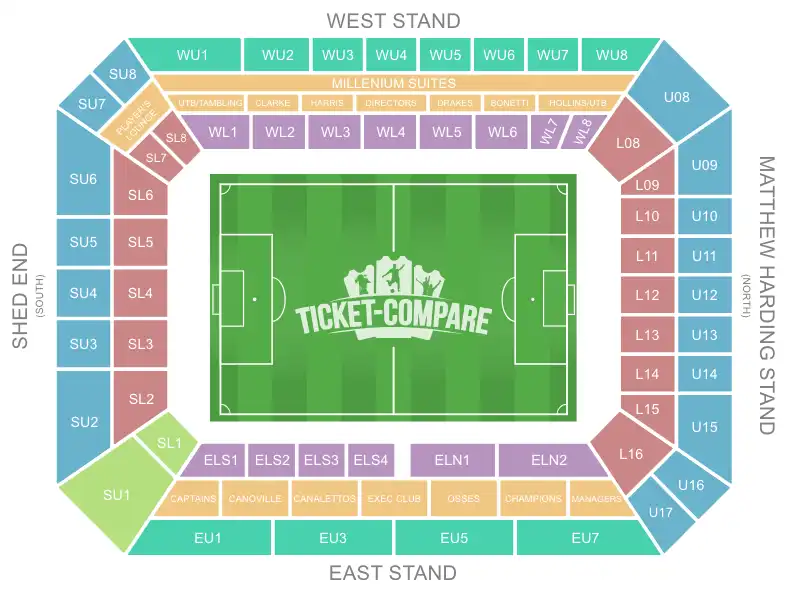Upcoming Matches
Chelsea vs Everton FC
Premier League・Stamford BridgeLondon, United Kingdomfrom £1062,036 available ticketsChelsea vs Aston Villa
Premier League・Stamford BridgeLondon, United Kingdomfrom £1694,969 available ticketsChelsea vs Bournemouth
Premier League・Stamford BridgeLondon, United Kingdomfrom £1585,124 available ticketsChelsea vs Brentford
Premier League・Stamford BridgeLondon, United Kingdomfrom £1076,235 available tickets
Stamford Bridge Seating Plan at a Glance
- Stamford Bridge Capacity: 40,173
- Opened: 1877 (Last major redevelopment: 2001)
- Safe Standing Spaces: 12,420
- Location: London (Fulham)
- UEFA Stadium Rating: Category 4
| Stand | Approx Capacity | Blocks | Approx Rows | Stand Details |
|---|---|---|---|---|
| Matthew Harding Stand | 10,880 | L08–L16, U08–U17 | 51 | Vocal lower tier, die-hard Blues support |
| East Stand | 11,000 | ELS1–ELS4, ELN1–ELN2, EU1–EU7 | 69 | Family-friendly longside with clear views |
| Shed End | 6,400 | SL1–SL8, SU1–SU8 | 32 | Iconic south end, raucous atmosphere with away fans |
| West Stand | 13,500 | WL1–WL8, WU1–WU8 | 71 | Premium stand with hospitality and new concourse for Upper Tier |
As the average Premier League stadium has grown in the last 20 years, Stamford Bridge is now at mid-table for matchday attendance, with a healthy capacity of 40,343. Plans to redevelop the ground into a 60,000+ seater venue were shelved in 2018 but have since been revived under the new ownership.
Today, Stamford Bridge is a stadium with plenty of quirks and a lot of personality. It can also be as loud as any in the league, with roofs and closed-off corners trapping the crowd noise. So for a full stand-by-stand breakdown, check out our guide to the Stamford Bridge seating plan.
The Stands at Stamford Bridge
The ground has four distinct stands, each with at least two tiers. As we mentioned, none of these stands was constructed as part of an all-encompassing expansion. Each one has a different story to tell, and offers a distinct experience on matchdays. Stamford Bridge’s capacity fluctuates from season to season, so the figures below are estimates.
Matthew Harding Stand at Stamford Bridge
Capacity: 10,880
Rows: 51
On the north side (shortside), the old North Stand was renamed in honour of former Chelsea director Matthew Harding, who died in a helicopter crash in 1996. During a tumultuous time at the club in the mid-1990s he provided a chunk of the investment for the redevelopment of this stand, which replaced a large section of open terracing, standing since the 1970s.
Outside this stand is the Chelsea Hub, home to the Chelsea F.C. Museum and Chelsea Health Club and Spa, connected to the stadium by an elevated walkway.
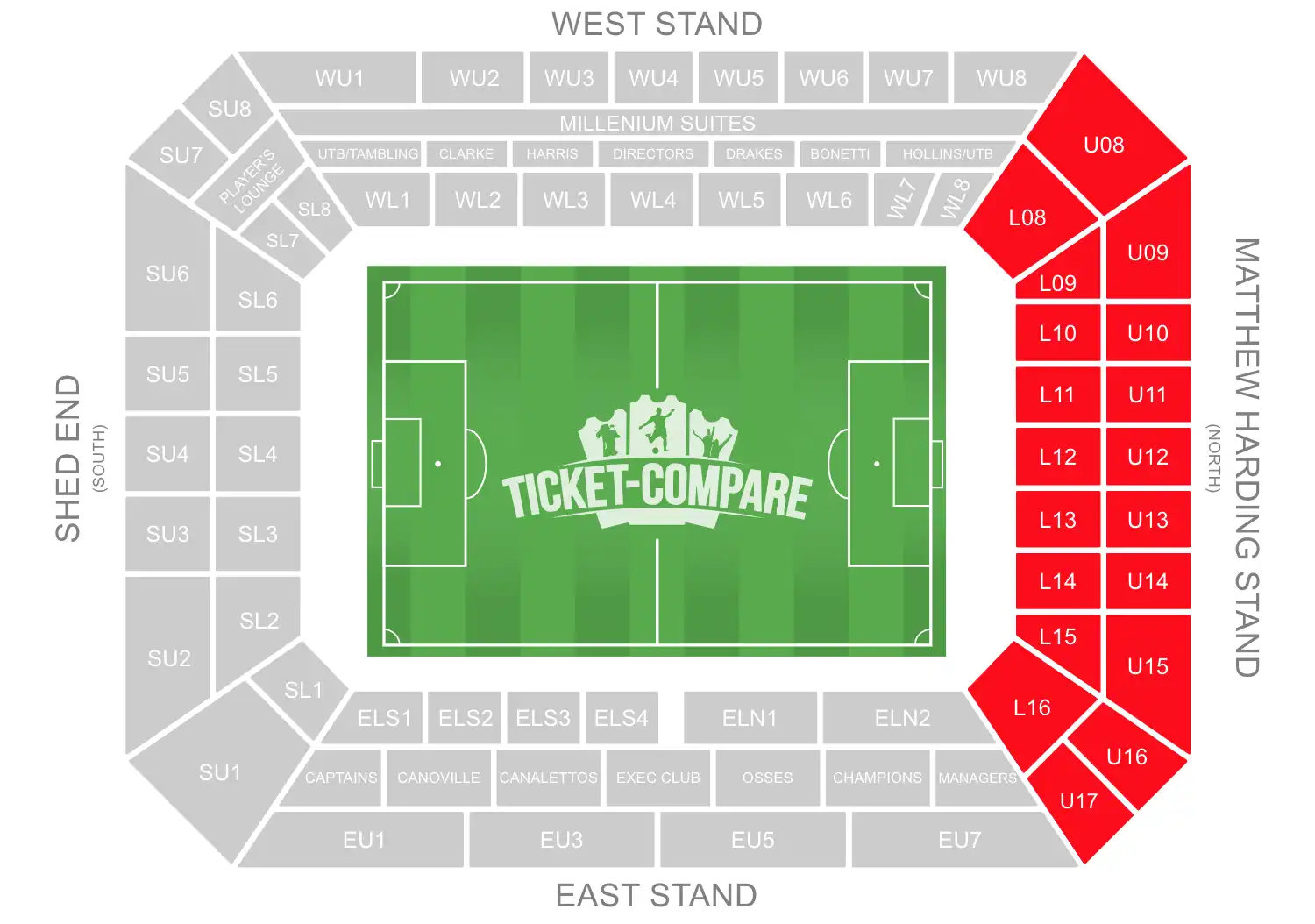
Chelsea fans agree that the Matthew Harding Stand has the best atmosphere in the stadium, particularly the Lower Tier. So this is the place to go if you want to be among the vocal, diehard Blues supporters. Fans will be on their feet, singing for the entire game.
If you want to follow every kick of the game, the view can be a little awkward behind the goal in the Lower Tier, but does improve in the Upper Tier, which strikes a nice balance between atmosphere and game perspective.
In the Lower Tier the rows ascend from A, by the pitch, to GG at the top. Then the Upper Tier rows run from A to R.
East Stand at Stamford Bridge
Capacity: 11,000
Rows: 69
On the longside, the oldest stand at Stamford Bridge dates back to the mid-1970s and was untouched by the large-scale redevelopment of the stadium in the 1990s. With three tiers, the East Stand was the first in the stadium to get a roof, and was built as part of a planned redevelopment of the entire stadium.
This work was cancelled when the club ran into financial trouble, and the East Stand survives in its original form, albeit with a lot of improvements and modernisations.
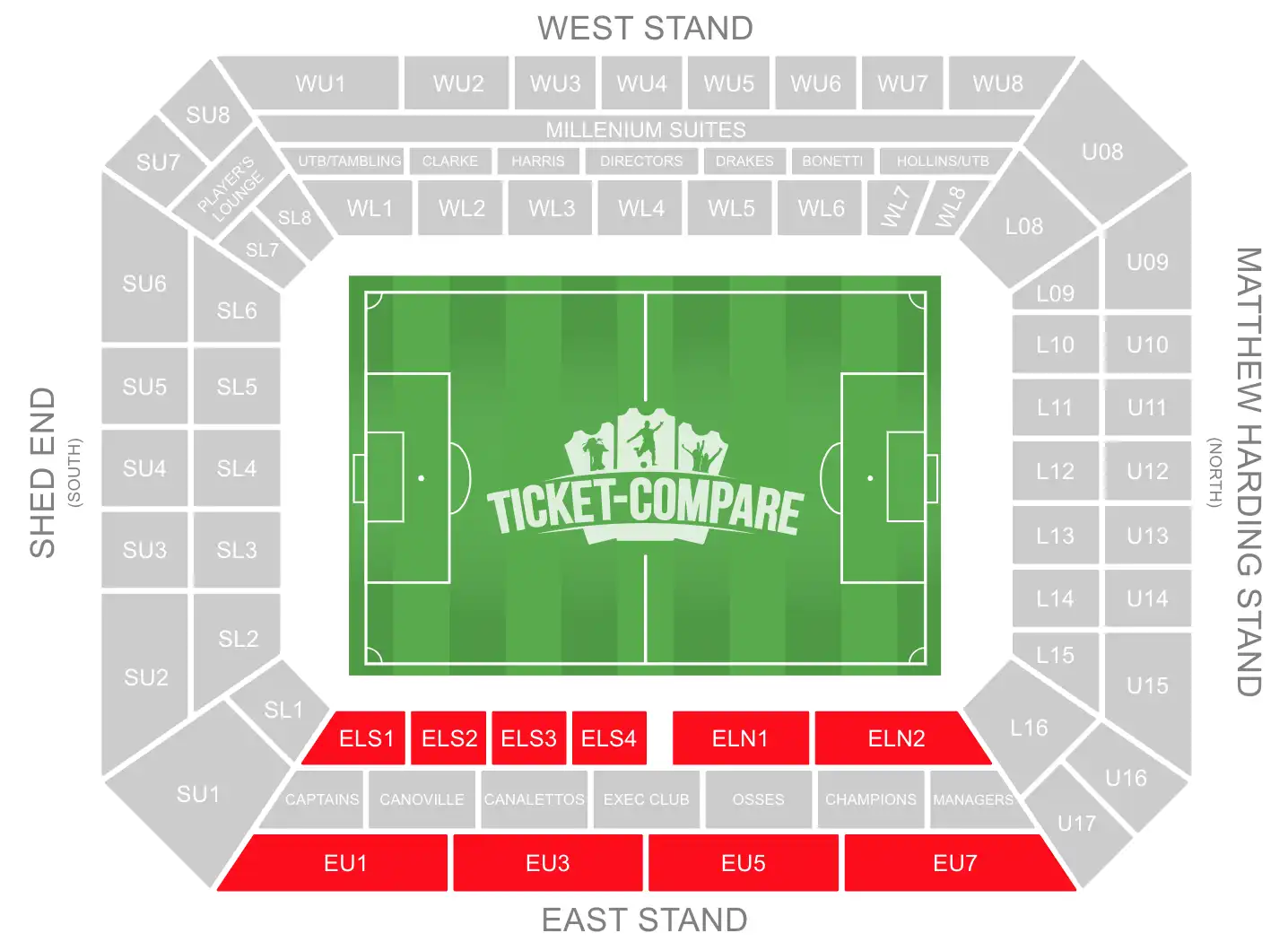
For decades, a large section of the Lower Tier was where the away supporters sat. In fact it was Jose Mourinho who relocated the away fans to the Shed End before 2005-05, as a way of improving the match-day atmosphere.
If you’re prioritising view over atmosphere, the East Stand is the place to be. Not to say that the fans don’t sing in this stand; more that it’s a family–oriented spot, reserved for younger and older fans, as well as those who have travelled from abroad to watch the match.
As well as containing the Family Centre, the East stand is home to the dugouts, the stadium’s press section, and two levels of exclusive suites and boxes.
The rows ascend from B to U in the Lower Tier, and then from A to R in the hospitality sections in the middle. The labelling system changes from letters to numerals in the Upper Stand, running finally from 1 at the bottom to 31 at the highest point.
Shed End at Stamford Bridge
Capacity: 6,400
Rows: 32
On the southern shortside, the Shed End is arguably the most iconic of Chelsea’s four stands. The name comes from the first half of the 20th century. The original Shed End, built in 1930, was known as the Fulham Road Stand, but was soon dubbed ‘The Shed’ by the Blues faithful.
The terracing that was here for decades was demolished in 1994 to bring Stamford Bridge in line with new safety standards following the Hillsborough disaster. Over the next few seasons, the south end of Stamford Bridge was transformed with a new all-seater stand and the Chelsea Village development that rises behind.
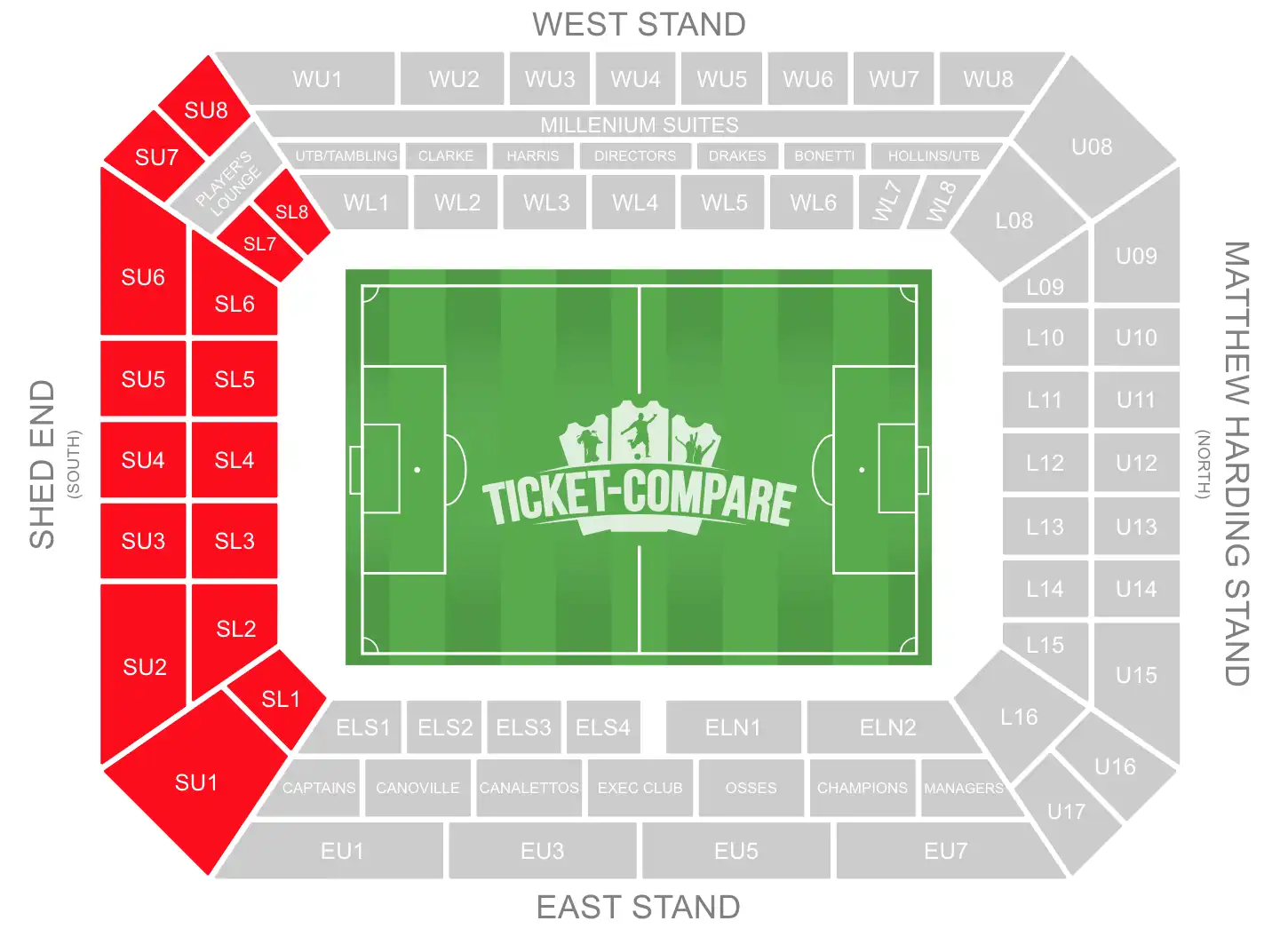
This end of the stadium features the Chelsea F.C. Megastore, two hotels, a residential development, along with a sports bar and tearoom, both open seven days a week.
The Shed End’s reputation as the hotbed of stalwart Chelsea fans was disrupted a little when the away section was moved here to the south-east side in the mid-2000s. Away fans are in blocks SL1-SL3 in the Shed Lower and blocks SU1-SU3 in Shed Upper, as well as some of SL4 and SU4, depending on the allocation.
Today the Shed End rivals the Matthew Harding Stand for an authentic match-day experience with a lot of noisy support. If you like interaction with away fans, then there’s a lot of harmless chanting between the two sets of supporters, especially for London derbies and games against other top PL sides.
The Shed End’s rows are labelled numerically, ascending from 1 to 14 in the Lower Tier, and then 1 to 18 in the Upper Tier.
West Stand at Stamford Bridge
Capacity: 13,500
Rows: 71
The most exclusive seats at Stamford Bridge are in the longside West Stand. As you see it now, this part of the stadium dates to 2001, replacing an earlier seated stand from the mid-1960s.
Construction of the West Stand helped bring about the Roman Abramovich era. The Owner/Chairman Ken Bates agreed to dangerous repayment terms on the loans for the project, which could have landed the club in administration before the takeover in 2003.
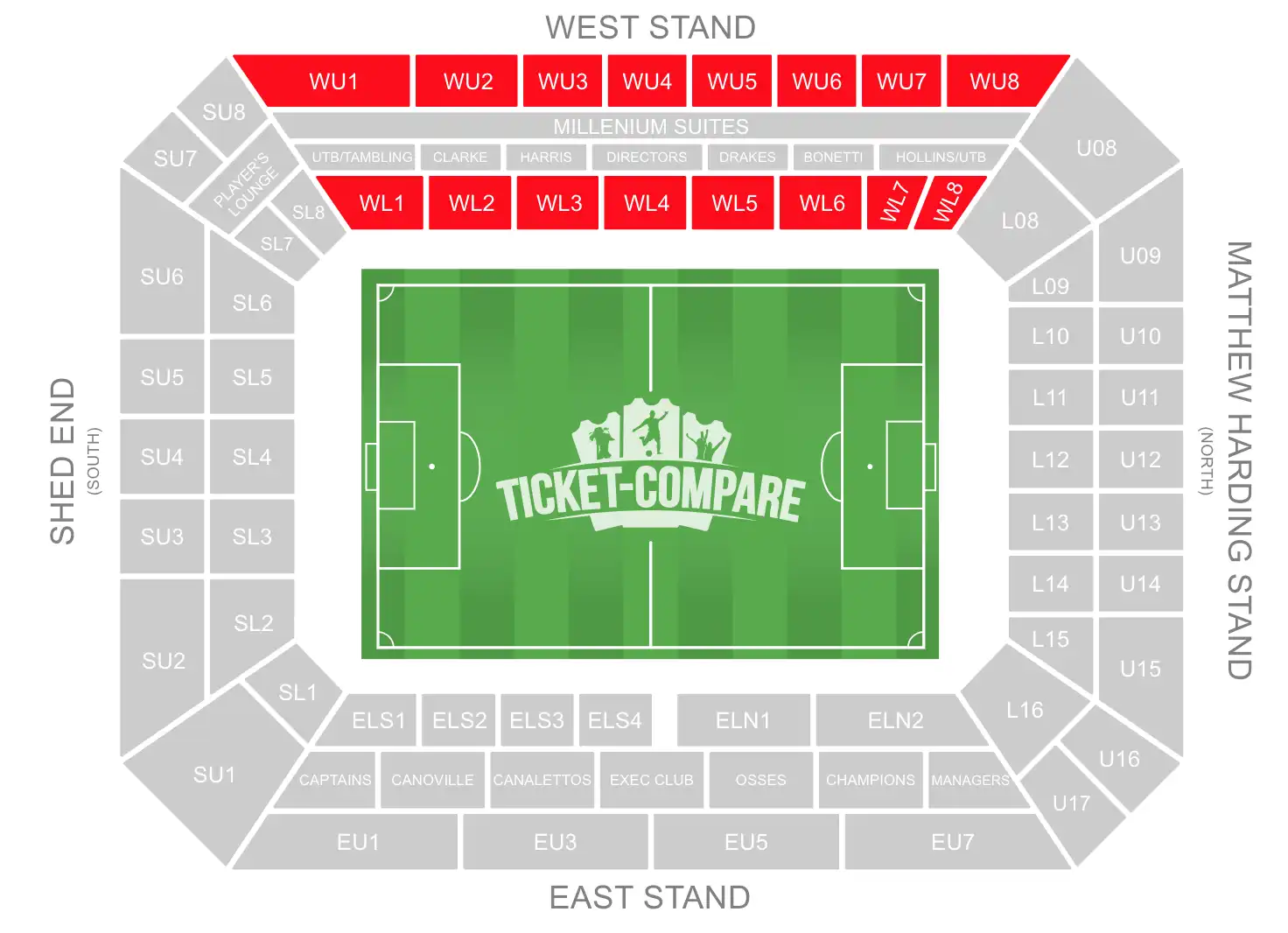
Coming through the main gate on Fulham Road, the West Stand, decorated with the club crest and flag, is the first thing you see. Below the crest is a statue of Blues hero Peter Osgood, who helped the club to an FA Cup in 1970 and a European Cup Winners’ Cup the following season.
As well as being home to much of Chelsea’s hospitality, the West Stand also holds the largest concourse of any in the stadium. This space, dubbed the ‘Great Hall’, is regularly used for club events like Chelsea Player of the Year.
The West Stand has three tiers, with Lower and Upper Tiers sandwiching the exclusive Middle Tier which is divided horizontally into three distinct strips.
In the lowest of these are the West Club Boxes, which sit below nine more exclusive suites including the Directors’ Box on the halfway line. Above these is another row of executive boxes, known as the Millennium Suites.
The Upper Tier blocks of the West Stand are home to the Westview Seats. These are premium seats, with superb views of the action and a state-of-the-art concourse, but without hospitality. Westview has its own season ticket category, which we talk about in our page on the Chelsea season ticket waiting list.
The rows in the West Stand are labelled with numbers in The Lower Tier (1-36) and Upper Tier (1-23). The Middle Tier is divided into three strips, running from A-B, A-H and A-C, in ascending order.
Where Should I Sit at Stamford Bridge?
For the Best Atmosphere
If you want to go home with your ears ringing with Chelsea songs, the best place to get Chelsea tickets is the Lower Tier of the Matthew Harding Stand, namely blocks L10 to L14. Following intense campaigning the Lower Tier of this stand has been approved for safe standing, which adds to the match-day fun. There is also safe standing in the Upper and Lower Tiers of the Shed End, although the presence of away fans means you don’t get the same wall of noise as the Matthew Harding Stand.
For the Best Views
The clearest views of the Stamford Bridge Pitch can be found in the East Stand and West Stand. If you want a TV perspective you could aim for the Upper Tier of the West Stand, which is where the television cameras and media are located.
For the Premium Experience
Again, most of Chelsea’s hospitality is concentrated in the East and West stands, with an emphasis on the latter. The West Stand is upscale throughout, but especially in the Middle Tier and Upper Tier, home to the Westview seats. We go into more detail on Chelsea’s wide variety of seasonal hospitality packages in our guide to Chelsea membership.
For Family Days Out
The Lower Tier of the East Stand is Chelsea’s designated Family Centre. In this part of the stadium, fans tone down their language and remain in their seats for the full match, apart from when there’s a goal. Meanwhile, senior fans favour East Upper, which has superior views and also welcomes younger members of the family.
Accessibility
Stamford Bridge ranks as one of the most accessible stadiums in the Premier League, with 223 wheelchair positions (30 in the away section). Home wheelchair platforms can be found at the front of Matthew Harding Upper, and pitchside and at the back of East Lower. They are also at the back of Shed Lower, pitchside in West Lower, and at the front of West Upper (Westview).
All accessible seats have a PA position next to or behind the wheelchair user. In addition, Stamford Bridge has 335 easy access home seats, and 21 away, while there are 16 accessible toilets throughout the stadium. These facilities meet or exceed the standards set out by the charity, Level Playing Field.
| Section | Blocks | Block Count |
|---|---|---|
| Away | SL1, SU1 SL1, SU1 | 2 |
| Longside Lower Tier | ELN1, ELN2, ELS1, ELS2, ELS3, ELS4, WL1, WL2, WL3, WL4, WL5, WL6, WL7, WL8 ELN1, ELN2, ELS1 | 14 |
| Longside Upper Tier | EU1, EU3, EU5, EU7, WU1, WU2, WU3, WU4, WU5, WU6, WU7, WU8 EU1, EU3, EU5 | 12 |
| Shortside Lower Tier | L08, L09, L10, L11, L12, L13, L14, L15, L16, SL2, SL3, SL4, SL5, SL6, SL7, SL8 L08, L09, L10 | 16 |
| Shortside Upper Tier | SU2, SU3, SU4, SU5, SU6, SU7, SU8, U08, U09, U10, U11, U12, U13, U14, U15, U16, U17 SU2, SU3, SU4 | 17 |
| VIP or Executive Box | BONETTI, CANALETTOS, CANOVILLE, CAPTAINS, CCBOX, CHAMPIONS, CLARKE, DIRECTORS, DRAKES, EXECUTIVE CLUB, HARRIS, HOLLINS, MANAGERS, MILLENIUM, OSSES, PLAYERS LOUNGE, TAMBLING, UTB NORTH, UTB SOUTH BONETTI, CANALETTOS, CANOVILLE | 19 |
